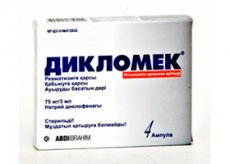Medical expert of the article
New publications
Preparations
Diclomec
Last reviewed: 04.07.2025

All iLive content is medically reviewed or fact checked to ensure as much factual accuracy as possible.
We have strict sourcing guidelines and only link to reputable media sites, academic research institutions and, whenever possible, medically peer reviewed studies. Note that the numbers in parentheses ([1], [2], etc.) are clickable links to these studies.
If you feel that any of our content is inaccurate, out-of-date, or otherwise questionable, please select it and press Ctrl + Enter.

Diclomec has local antirheumatic, anti-inflammatory, antipyretic and analgesic activity.
The drug slows down the binding of PG at the COX level, thereby affecting inflammatory pathogenesis, as well as the processes of fever and pain.
In case of rheumatic diseases, the analgesic and anti-inflammatory properties of the drug help to significantly reduce the intensity of pain, joint swelling and stiffness in the morning. In case of injuries, the drug reduces inflammatory swelling and pain.
Indications Diclomeca
It is used to perform symptomatic procedures for the following disorders:
- osteoarthritis affecting the peripheral and vertebral joints;
- injury-related inflammation of ligaments, tendons, joints or muscles (bruises, strains or sprains);
- localized types of rheumatic lesions in the soft tissue area (including bursitis with tendovaginitis, periarthritis and shoulder-bone syndrome).
Release form
The component is released in the form of a gel, inside a 50 g tube.
Pharmacokinetics
After local application of the gel containing diclofenac, only a small part of the substance is absorbed into the blood. Because of this, the drug does not have a systemic toxic effect. After treating the damaged epidermis, a film is formed on it, from which the active component is gradually released, penetrating deep into the subcutaneous tissues. It has been determined that inside the fluid obtained from the area of joint inflammation, as well as synovia, the drug indicators are higher than inside the plasma, which confirms the local effect of the drug.
Excretion occurs with urine - in an unchanged state and in the form of metabolic components.
Dosing and administration
A child over 6 years old, as well as an adult, should apply a gel strip (about 4-8 cm) to the epidermis in the affected area, then rub it in with light movements. After finishing the treatment, wash your hands.
This procedure should be repeated 3-4 times a day over a 10-14 day period.
 [ 2 ]
[ 2 ]
Use Diclomeca during pregnancy
There is no experience of using Diclomec during breastfeeding or pregnancy. For this reason, it is not used in this group of patients.
Contraindications
It is contraindicated to prescribe the drug in case of severe intolerance associated with aspirin and other NSAIDs, or with the components of the drug.
Side effects Diclomeca
Occasionally, the use of the gel may provoke erythema, itching or burning sensation. In case of prolonged use on large areas of the epidermis, systemic signs of allergy in the form of epidermal rashes may be observed.
 [ 1 ]
[ 1 ]
Storage conditions
Diclomec must be stored in a place closed to small children. Temperature indicators - no more than 25 ° C.
Shelf life
Diclomec can be used for a period of 4 years from the date of manufacture of the drug.
Application for children
The medication cannot be used in children under 6 years of age due to the lack of data on its use in this category of patients.
 [ 3 ]
[ 3 ]
Analogues
The analogs of the drug are the substances Diclac, Olfen, Clodifen with Dicloran Plus, Itami, Diclofenac and Naklofen with DicloFlex.
Attention!
To simplify the perception of information, this instruction for use of the drug "Diclomec" translated and presented in a special form on the basis of the official instructions for medical use of the drug. Before use read the annotation that came directly to medicines.
Description provided for informational purposes and is not a guide to self-healing. The need for this drug, the purpose of the treatment regimen, methods and dose of the drug is determined solely by the attending physician. Self-medication is dangerous for your health.

